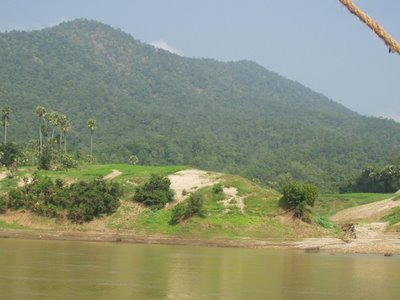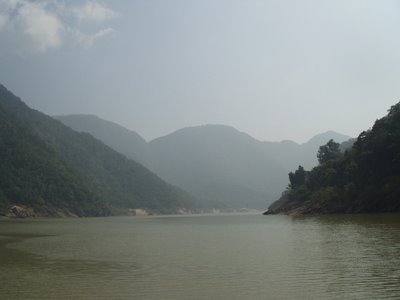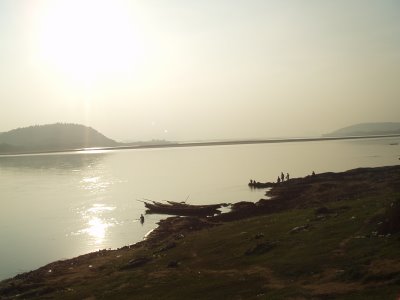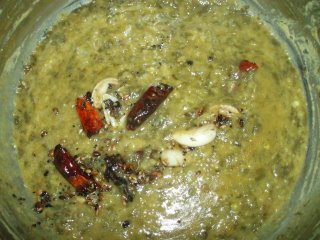
This chicken was an afterthought. It’s been ages since we summoned up the energy to buy and cook any meat at home — it involves a long, smelly, unhygienic and fly-ridden wait at the butcher’s, and the only time we have is Sunday mornings. Go a little late and you have to come back empty-handed. However, having found it in our weekly shopping expedition all nice and wrapped up sans the usual puddles and sticky splotches of bloody ooze on the shelves of the chiller (another big put-off), we bought it and turned it into one of the tastiest chicken curries we’ve ever made. Now I know how to make a South Indian ‘military’ hotel-type chicken curry – it may not be the exact recipe, I may not ever make it again, but it smelt just like it and I know how to do it, isn’t it thrilling? All those days of wondering why we never ever get that rich brown colour, that thick gravy, that flavour – well, all will be revealed soon!
(For those who don’t know what a military hotel is, it’s the term used in South India (in North too?) by a non-vegetarian hotel to distinguish itself from a meatless one – probably because of the belief that soldiers in the army eat a lot of meat everyday to gain and keep up their strength. It also serves very well to keep vegetarians from straying into its precincts!)
I’ve called it Random because I just threw in whatever I had by way of marinade, there was no recipe and the measures were slapdash:
Two ladles of fresh curds
Two fat pinches of turmeric
A tablespoon of ginger-garlic paste
Some Sambaar kaaram (a chilli powder mix with garlic, salt and coriander, NOT to be mistaken for saambaar podi/powder)
A really hefty pinch of curry powder/garam masala
Some more salt and coriander powder
I mixed in the marinade really well and sat the whole thing in the refrigerator for about three hours.
Siesta over, here’s what you need to do:
Chop two onions
Slit three green chillies (one of mine had turned a ripe red)
Fry them in three tbsps of oil
Throw in some leftover mint leaves (mine were 10 days old) and a few coriander leaves/cilantro
Add a couple of bay leaves
Fry this till all of it wilts
Then put in the chicken with the marinade, pour a little more water and cook covered on medium fire. Throw in a fistful of curry leaves, stir. (Voila, this is what gives it that military hotel taste!) Keep turning every five or seven minutes. Check the chicken for ‘doneness’, seasoning and add some more curry powder at the end. Simmer longer if you want a thicker gravy. Sprinkle with chopped coriander leaves. Soft, hot rice is a good accompaniment. Truly a lip-smacking, tasty dish which leaves your home fragrant for the rest of the day!
The other one is an old favourite which comes with its own story – read about it further down!

Funny how I forgot this dish existed and was a great favourite with me when my Grandmom was cooking! I recently saw a post on Masala Magic for Beerakaaya Pappu made with toor daal but as I said in my comment there, this was one daal that escaped our home, and the homes of others I knew. We made many others, though – with tomato, raw mango, a variety of greens, dosakaaya (cucumber/melon cucumber, as it was called in one of these blogs), vaakkaaya (sour little purple-green berries) …
Many days later, however, I suddenly remembered this dish. And I know why Beerakaya Pappu sounded unusual to me – we didn’t call our version by that name, but with an extra detail added – Beerakaaya Senagapappu, for the Bengal gram/yellow lentil that went into it. I remember Gran cooking a huge quantity of this and once even freezing it; for two or three days in a row, she would take this speckled green-and-yellow dish sparkling with ice out of the freezer, ladle a few servings into another dish, heat it and serve it.
I wasn’t interested in cooking then, and I couldn’t find the recipe in any book that I have now, but found one for ridge gourd with toor daal that promised to emulate the consistency of this old favourite. Only, it didn’t turn out as great as my Gran’s. This one used tamarind, I’m not sure hers did.
Here's how:
Ridge gourd/Beerakaya, diced – 250 gm
Bengal gram/yellow lentil/channa daal – 1 cup
Onion, chopped – 1
Tamarind – Lime-sized
Green chillies, slit – 6
Chilli powder – to taste, but half a tsp would do
Turmeric – a pinch
Salt
For the tempering:
Mustard seed – 1 tsp
Jeera/Cumin – ½ tsp
Black gram/split urad daal/minapa pappu – 1 tsp
Garlic, squished under the knife – 4-5 cloves
Dry, red chillies – a couple
Curry leaves – a few
Coriander leaves/cilantro, chopped – a fistful
Oil – 1-2 tsps
Soak the daal in water for a couple of hours, then cook with some water – it has to hold its shape. Then put in the ridge gourd, onion, green chillies, salt, turmeric and chilli powder and cook for another 5 minutes. Extract the juice from the tamarind, add it to the pot and cook some more. Or you can cook it in a pressure cooker/pan from the beginning but use the weight only at this stage. After one hiss, take it off the fire. Wait for the pressure to come down on its own. Don’t force the weight open, it’s dangerous.
In a small frying pan, heat the oil, splutter mustard, cumin and black gram, then the garlic, then the red chillies and curry leaves. Make sure it doesn’t burn and blacken. Pour this into the daal, garnish with coriander leaves. Serve with rice or even puris/chapathis. As you like it!
Tags: chicken military hotel beerakaya/ridge gourd








